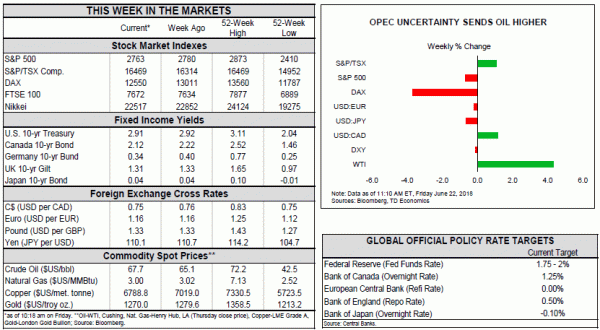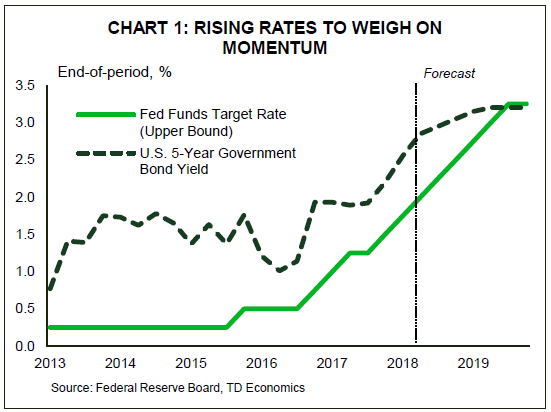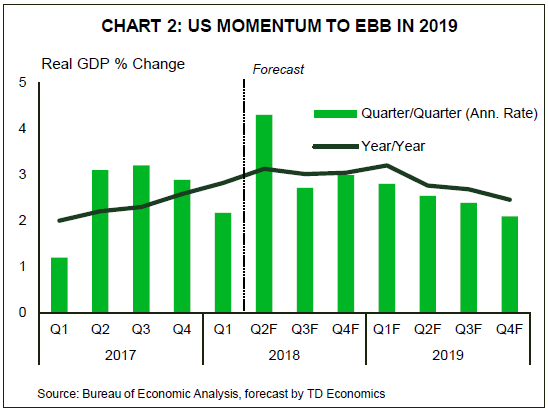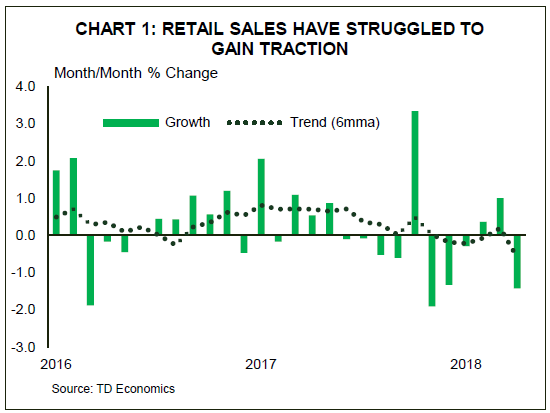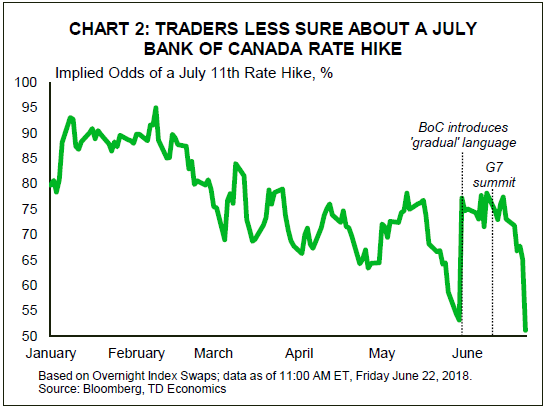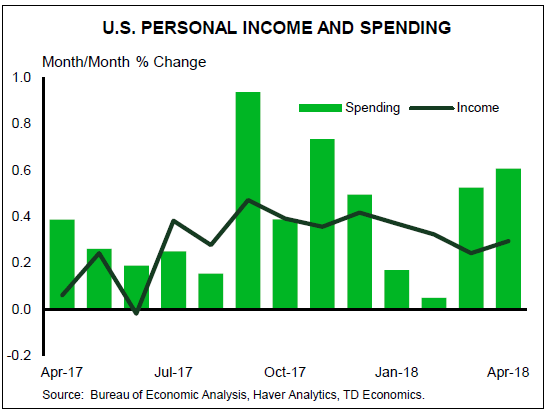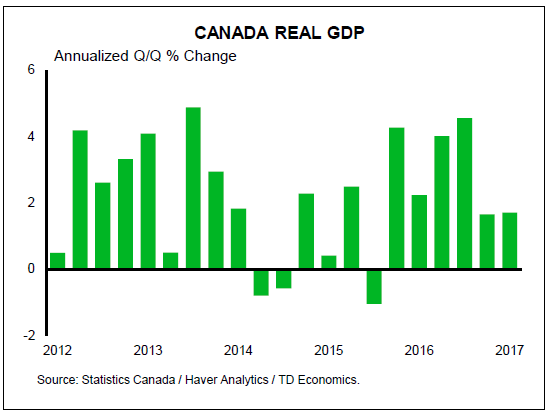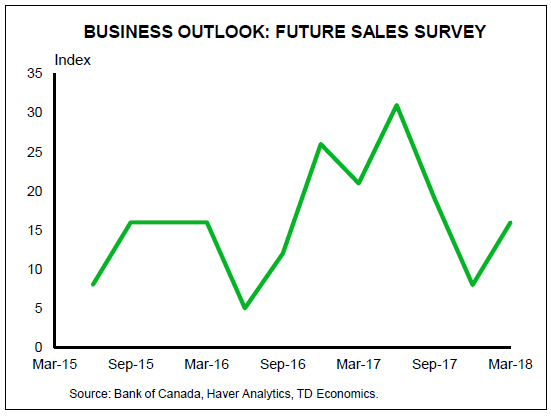U.S. Highlights
- The U.S. economy is barreling ahead with more momentum than we had expected. Our latest forecast upgrades real GDP growth to 3.0% in 2018, from 2.7% in March.
- 3% is difficult to sustain over the medium term. As the fiscal boost fades, higher interest rates weigh and structural constraints bind, growth in 2019 is set to slow.
- Even with slower growth, the U.S. is still set to out-perform its G7 peers. The main downside risk to the outlook is an escalating trade war. While this presents a serious risk to its trading partners that are dependent on access to the U.S. market, America has sufficient cushion to withstand the hit.
Canadian Highlights
- Canadian economic data were generally gloomy this week. April’s wholesale trade numbers came in flat, while auto sales led retail trade lower.
- Prices also failed to gain momentum, with inflation unchanged at 2.2% in May.
- Trade tensions and softening data led traders to lower the odds of a July Bank of Canada rate hike to an effective coin toss – an underestimate in our opinion. The upcoming speech by Governor Poloz is one to watch as we get ready for the next monetary policy decision on July 11.
U.S. – Let the Good Times Roll!
Our new quarterly forecast is titled Full Steam Ahead, which is an accurate description of our forecast. The American economy is barreling ahead with more momentum than we had expected. Real GDP growth is tracking 3.0% in 2018, revised up from 2.7% in our March forecast. This is a notable improvement from 2.3% in 2017, thanks in large part to fiscal stimulus.
A healthy economy is set to push the unemployment rate even lower over the coming quarters. This in turn will add to inflation pressures. Stronger economic momentum and firming inflation have prompted us to edge up our rate-hike expectation by an additional 25 basis points for this year, taking the upper end of the policy range to 2.5% by year end.
At the risk of sounding like a broken record, 3% growth is difficult to sustain beyond a near-term cyclical updraft. The boost from tax cuts and government spending increases will start to fade next year. Add to that the reduced lift from monetary policy. The Fed has raised its policy rate 150 basis points over the past 18 months, and is expected to raise it 125 more over the next 18 months (Chart 1). Higher oil prices than in our previous forecast will also nip at consumer and businesses’ purchasing power. These cyclical concerns add to the underlying structural dynamics of the US economy. Even with an expected improvement in productivity growth, an aging population holds potential growth in the economy to roughly 2%.
All of these factors mean that on a quarterly basis growth is set to slow over the course of 2019, to 2.1% by the end of the year (Chart 2). Still, this should be kept in perspective. Even as the U.S. slows, it is expected to outpace all other G7 economies (see Global Outlook). And, when an economy is already running at 3%, the only real direction for it is to slow.
Now is the time in the economic cycle where so –called “animal spirits” can lead to excess risk taking, and sow the seeds of the next recession. For the U.S. it is as yet unclear what these unknowns might be. Indeed the factors that cause the next recession may come from outside the U.S.’s borders. But one potential risk is self-inflicted. An escalating trade war is a clear downside risk, particularly for the U.S.’s key trading partners (see impacts of auto tariffs on Canada), which would have knock on impacts at home. Even so, with the economy doing so well, it has sufficient economic cushion to absorb some negative shocks.
In an otherwise quiet week for economic data, we did get an update on the trigger of the last recession – the housing market. There a few signs of froth there. Housing starts continued their gradual upward trend in May. Residential construction has been on a stronger footing this year after weakness in multi-unit structures drove a lull in 2017. The existing home market, on the other hand, was a bit disappointing in May. Sales have trended down recently, as the market struggles with a lack of listings. Forward looking indicators suggests activity should improve in the months ahead. In time, construction of new homes should help, but improvement is expected to be gradual as affordability constrains demand.
Canada – Back To You, Governor
Data released this week provided additional signals of how the Canadian economy is shaping up in the second quarter. Wholesale trade figures came in effectively flat, as a pull-back in autos weighed on overall activity. Notably, this came on the back of an impressive (and now upwardly revised) earlier performance, making April an all-time high.
Weak data became a theme for the week as retail sales recorded a sizeable decline, and inflation came in on the soft side. On the retail front, the pull-back was driven almost entirely by the decline in auto sales. A decline was largely expected, given outsized gains in the months prior, but the correction was more severe than anticipated. Although Statistics Canada suggests that at least some of the decline was related to poor weather, the weakness comes at a time when retail sales were already struggling to gain traction (Chart 1). April’s decline marks the fourth in six months. So while the data disappointed, it is at least consistent with recent trends.
The inflation report also disappointed, with year on year price growth unchanged at 2.2% in May, well short of market expectations. Here too some one-off factors impacted the data, with a 7.1% y/y drop in telephone service costs standing out. However, since the Bank of Canada’s core measures also pulled back, the softness in inflation appears more widespread.
Chart 2: Traders less sure about a july Bank of Canada rate hike
Looking ahead, these signals will become a signpost with the release of April’s GDP report on Friday. The figures will likely show the economy started the second quarter on the back foot. However, the main event will likely be the speech by Bank of Canada Governor Poloz on Wednesday. The title “Let Me Be Clear: From Transparency to Trust and Understanding” telegraphs a high-level discussion on monetary policy, but with the next decision coming two weeks later every word will surely be scrutinized. Recent communications have been on the hawkish side, but in the wake of trade tensions, the market-implied odds of July action have been falling, with today’s soft data relegating it to an effective coin flip (Chart 2). This shift in sentiment seems a bit overdone. To be sure, as our recent ‘what if’ analysis of potential auto tariffs demonstrated, the impacts of further trade actions would be significant. Fortunately, for now, these are just risks, and they are not new. In fact, these very risks sit at the core of what the Bank has termed a ‘gradual’ approach to monetary policy, alongside concerns over leverage and housing markets.
So it remains the case, as outlined in our latest Quarterly Economic Forecast, that for the Bank of Canada, risks do not imply inaction. So long as the data remains broadly constructive, the Bank is likely to feel comfortable continuing to remove stimulus. On that front, the Business Outlook Survey, due Friday, as well as the monthly household credit data, likely to come the following weekend, will be useful to watch. The term ‘gradual’ implies that this process should be much slower than past experience would suggest. Unless these risks are sufficiently reduced or Canada’s economy accelerates markedly, we expect the Bank to move its policy rate by only 50bps (i.e. two hikes) per year. As it stands, July remains most opportune time to hike, but with inflation remaining tame it is hard to expect much urgency. Suffice it to say that there will be much in the coming weeks to test this view – stay tuned.
U.S.: Upcoming Key Economic Releases
Personal Income & Spending – May
- Release Date: June 29, 2018
- Previous Result: Income 0.4% m/m, Spending 0.2% m/m
- TD Forecast: Income 0.3% m/m, Spending 0.4% m/m
- Consensus: Income 0.4% m/m, Spending 0.4% m/m
We expect an upbeat tone from May PCE data with few surprises. PCE inflation should accelerate to 2.2%, with energy and food prices offsetting each other on a m/m basis and core PCE printing 0.2% m/m. That will lead the Fed’s inflation gauge higher to 1.9%, just below target. Personal spending should advance 0.4%, supporting robust Q2 expenditures above a 3% pace.
Canada: Upcoming Key Economic Releases
Real GDP – April
- Release Date: June 29, 2018
- Previous Result: 0.3% m/m
- TD Forecast: -0.1%
- Consensus: N/A
TD looks for industry-level GDP to edge 0.1% lower in April. Manufacturing output will be constrained by refinery shutdowns, which drove an outsized pullback in factory sales for the month, but stronger motor vehicle output should provide a partial offset. Construction should also provide less of a tailwind than recent months on the slowdown in the residential component. For services, we expect continued weakness in real estate due to the soggy housing market while food services and retail add another source of downside due to inclement weather. This may seem like a shock of cold water ahead of the July BoC, but we would note that the 0.3% print in March provides some insurance for Q2 should we get a weak print in April. Thus, we think the Bank will be comfortable to look through one month of poor data, especially considering weather and other one-offs, and hike rates in July as trade risks will continue to generate noise in the months ahead.
Business Outlook Survey – Q2
- Release Date: June 29, 2018
We look for the Business Outlook Survey to balance an upbeat assessment of current business conditions with more temperate forward looking commentary as trade risks cast a dark shadow over an otherwise healthy base case, underpinned by strong US demand. While most of the recent apprehension towards the BoC reflects a perceived increase in trade tensions out of the G7, this is the same type of environment that the Bank has operated in since President Trump announced his intent to renegotiate NAFTA in May 2017. Thus, the BoC will not overreact to noise, until that noise starts to impact investment decisions. In this light the quantitative indicators in the BOS should provide more insight than the anecdotes and we do not expect to see any significant deterioration since April, especially considering the consultation period concluded by early June at the latest.




